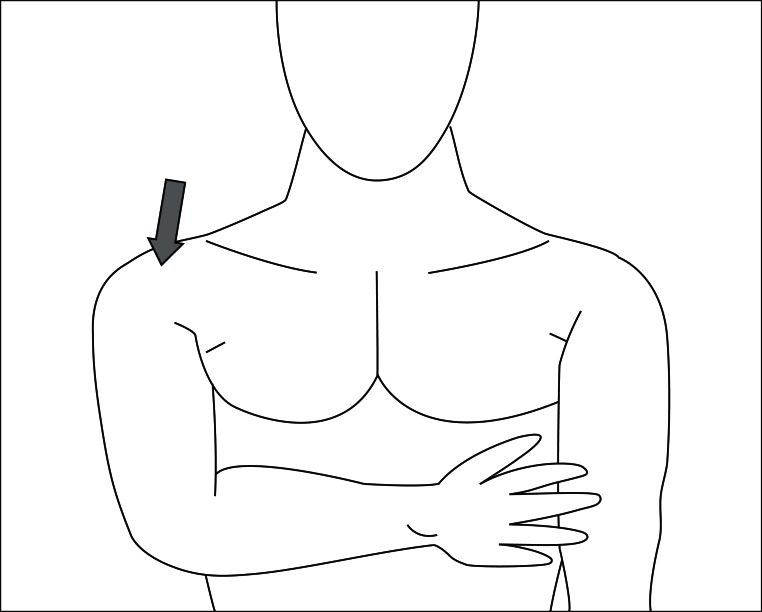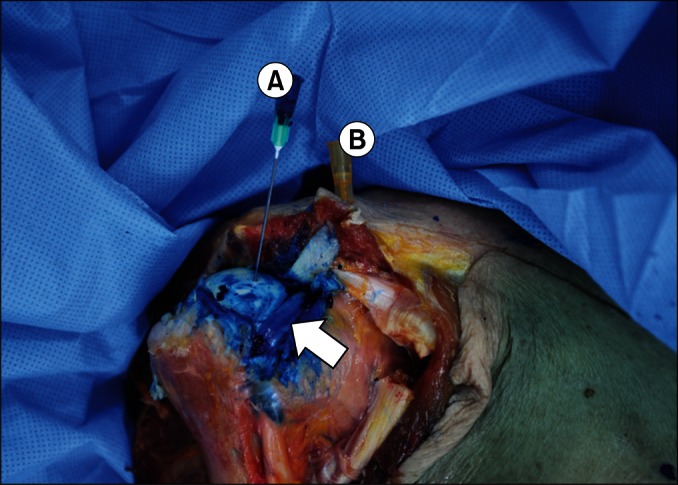Ann Rehabil Med.
2013 Apr;37(2):202-207. 10.5535/arm.2013.37.2.202.
Indirect Ultrasound Guidance Increased Accuracy of the Glenohumeral Injection Using the Superior Approach: A Cadaveric Study of Injection Accuracy
- Affiliations
-
- 1Department of Physical Medicine and Rehabilitation, St. Vincent's Hospital, The Catholic University of Korea College of Medicine, Suwon, Korea. dyfree@naver.com
- KMID: 2165771
- DOI: http://doi.org/10.5535/arm.2013.37.2.202
Abstract
OBJECTIVE
To investigate whether or not indirect ultrasound guidance could increase the accuracy of the glenohumeral joint injection using the superior approach.
METHODS
Twelve shoulders from 7 adult cadavers were anatomically dissected after a dye injection had been performed, while the cadavers were in the supine position. Before the injection, a clinician determined the injection point using the ultrasound and the more internal axial arm rotation was compared to how it was positioned in a previous study. Injection confidence scores and injection accuracy scores were rated.
RESULTS
The clinician's confidence score was high in 92% (11 of 12 shoulders) and the injection accuracy scores were 100% (12 of 12 shoulders). The long heads of the biceps tendons were not penetrated.
CONCLUSION
Indirect ultrasound guidance and positioning shoulder adducted at 10degrees and internally rotated at 60degrees-70degrees during the superior glenohumeral joint injection would be an effective method to avoid damage to the long head of biceps tendons and to produce a highly accurate injection.
Keyword
Figure
Reference
-
1. Kim JS, Yun JS, Kim JM, Ko YJ, Rhee WI, Ha NK, et al. Accuracy of the glenohumeral injection using the superior approach: a cadaveric study of injection accuracy. Am J Phys Med Rehabil. 2010; 89:755–758. PMID: 20581652.2. Johnson TS, Mesfin A, Farmer KW, McGuigan LA, Alamo IG, Jones LC, et al. Accuracy of intra-articular glenohumeral injections: the anterosuperior technique with arthroscopic documentation. Arthroscopy. 2011; 27:745–749. PMID: 21624668.
Article3. Itoi E, Motzkin NE, Morrey BF, An KN. Stabilizing function of the long head of the biceps in the hanging arm position. J Shoulder Elbow Surg. 1994; 3:135–142. PMID: 22959689.
Article4. Rutten MJ, Collins JM, Maresch BJ, Smeets JH, Janssen CM, Kiemeney LA, et al. Glenohumeral joint injection: a comparative study of ultrasound and fluoroscopically guided techniques before MR arthrography. Eur Radiol. 2009; 19:722–730. PMID: 18958474.
Article5. Ohara T, Itoh Y, Itoh K. Ultrasound instruments as possible vectors of staphylococcal infection. J Hosp Infect. 1998; 40:73–77. PMID: 9777525.
Article6. Kim JS, Kwon JY, Jeong IS, Rhee WI, Im S, Kim HJ, et al. The success rate of superior approach glenohumeral injection in patients with frozen shoulder. J Korean Acad Rehabil Med. 2007; 31:37–40.7. Hulstyn MJ, Fadale PD. Arthroscopic anatomy of the shoulder. Orthop Clin North Am. 1995; 26:597–612. PMID: 7566907.
Article8. Stitik TP, Foye PM, Fossati J. Shoulder injections for osteoarthritis and other disorders. Phys Med Rehabil Clin N Am. 2004; 15:407–446. PMID: 15145424.
Article9. Wolf EM. Anterior portals in shoulder arthroscopy. Arthroscopy. 1989; 5:201–208. PMID: 2775394.
Article10. Wong PL, Tan HC. A review on frozen shoulder. Singapore Med J. 2010; 51:694–697. PMID: 20938608.
- Full Text Links
- Actions
-
Cited
- CITED
-
- Close
- Share
- Similar articles
-
- The Success Rate of Superior Approach Glenohumeral Injection in Patients with Frozen Shoulder
- Ultrasound Guidance for Intra-Articular Shoulder Injections for Frozen Shoulder
- The Success Rate of Posterior Approach Glenohumeral Injection in Patients with Adhesive Capsulitis
- Ultrasonography Guided Glenohumeral Injection Using an Anterior Approach: A Cadaveric Study
- Distal biceps tendon injection




